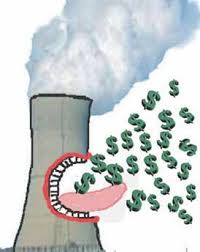I have often mentioned that there are serious problems with getting investors interested in nuclear power. Today, I will drill down into this subject a bit more. The International Energy Agency recently published a report on the World Energy Investment Outlook covering the next twenty years.
Annual global spending on energy is estimated to rise from one trillions six hundred million in 2013 to two trillion by 2035. Less than half of the forty trillion that will be spent between 2013 and 2035 will go to meet growth in energy demand. The rest will be spent will be used to " offset declining production from existing oil and gas fields and to replace power plants and other assets that reach the end of their productive life."
About sixteen trillion four hundred million dollars of the forty trillion will be spent on electricity. Forty percent of this will be spent on transmission and distribution of electricity. Only six percent of the electricity budget is slated to be spent on nuclear assuming a modest growth in the use of nuclear power. Six percent of electric power investment for nuclear projects does not seem like a lot but there is fierce competition for every dollar spent on electricity.
Nuclear projects use to be considered good investments because the energy was usually presold at a fixed price that guaranteed a good long term return on investment. Recently the turbulence in the energy market including low cost natural gas from fracking has brought an end to this practice. Now nuclear will have to sell into the short term market and may not be price competitive. For the past fifteen years, the U.S. reactors have been burning fuel made from decommissioned Russian nuclear warheads. The cost of this fuel was well below the cost of new uranium fuel. This program just ended so the price of nuclear fuel will rise. By some estimates, the world has already passed peak uranium production.
Many of the world's power reactors are nearing the end of their original licensed lifetimes. They are becoming more and more expensive to keep operating and some have already been shut down because they could not compete in the energy market. So investing in existing nuclear power plants is problematic. Investing in new reactors is risky because many of the new designs have not been built, tested and approved yet.
Perhaps the biggest reason to be wary of investing in nuclear power is that there will most probably be another major nuclear accident in the next few year. There could be deliberate terrorist attacks on nuclear power plants. Nuclear power plants could be destroyed intentionally or accidentally in regional conflicts. If any of these things happen, the public backlash against nuclear power will definitely make it less attractive as an investment.
Individual nuclear power projects required enormous funding which can be in the billions. Many different factors are involved in investment decisions. In the end, what really matters is the confidence that investors have in profiting from their investment over time. Given the problems discussed above, it is not a mystery why nuclear power is having problems finding investors.
